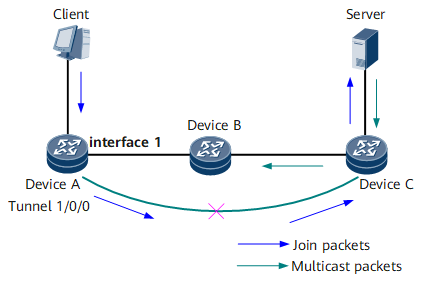OSPF Local MT
Background
When multicast and an IGP Shortcut-enabled MPLS TE tunnel are configured on a network, the outbound interface of the route calculated by an IGP may not be a physical interface but a TE tunnel interface. The TE tunnel interface on the Device sends multicast Join packets over a unicast route to the multicast source address. The multicast Join packets are transparent to the Device through which the TE tunnel passes. As a result, the Device through which the TE tunnel passes cannot generate multicast forwarding entries.
To resolve the problem, configure OSPF local multicast topology (MT) to create a multicast routing table for multicast packet forwarding.
Principles
On the network shown in Figure 1, multicast and an IGP Shortcut-enabled MPLS TE tunnel are configured, and the TE tunnel passes through Device B. As a result, Device B cannot generate multicast forwarding entries.
Since the TE tunnel is unidirectional, multicast data packets from the multicast source are sent to a physical interface of Device B. Device B discards these packets, because Device B has no multicast forwarding entry. As a result, services are interrupted.
After local MT is enabled, if the outbound interface of a calculated route is an IGP Shortcut-enabled TE tunnel interface, the route management (RM) module creates an independent Multicast IGP (MIGP) routing table for the multicast protocol, calculates a physical outbound interface for the route, and adds the route to the MIGP routing table. Multicast packets are then forwarded along this route.
After receiving multicast Join packets from Client, interface 1 on Device A forwards these packets to Device B. With local MT enabled, Device B can generate multicast forwarding entries.
